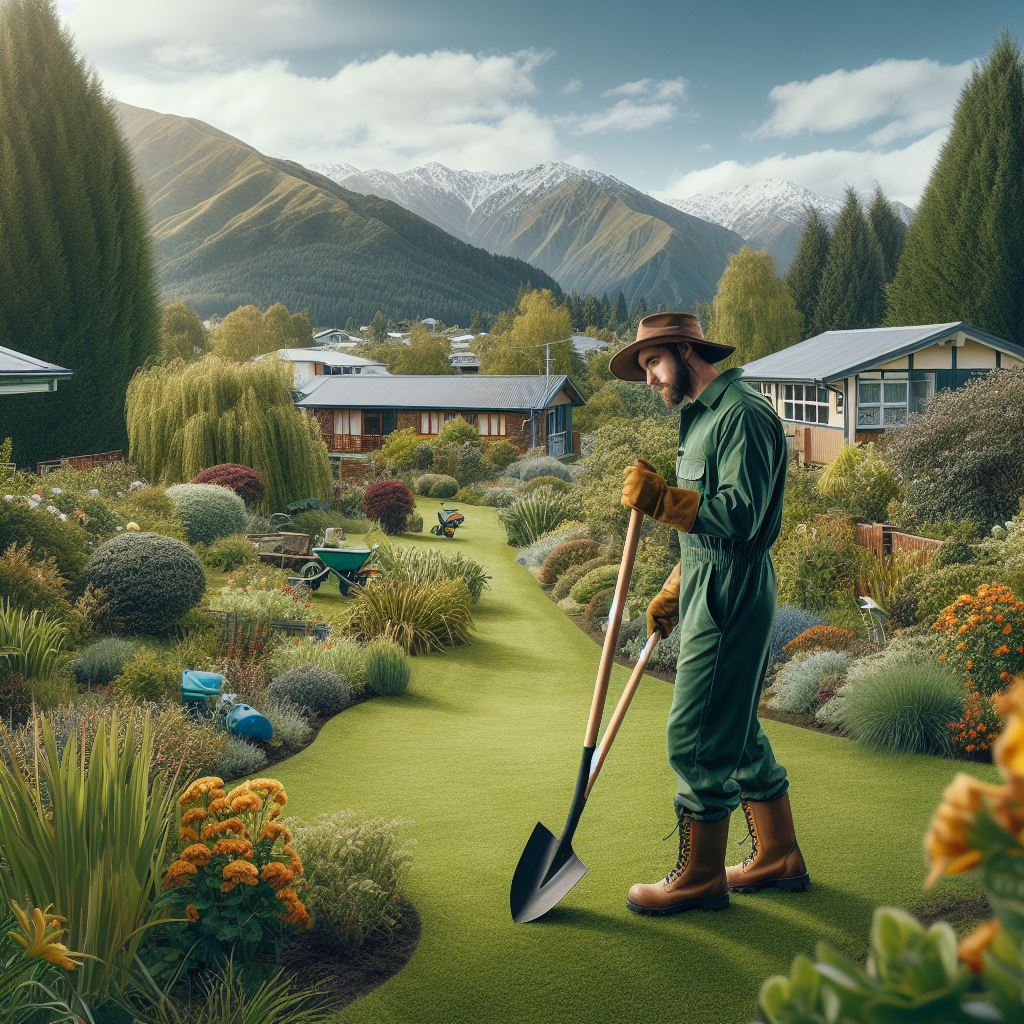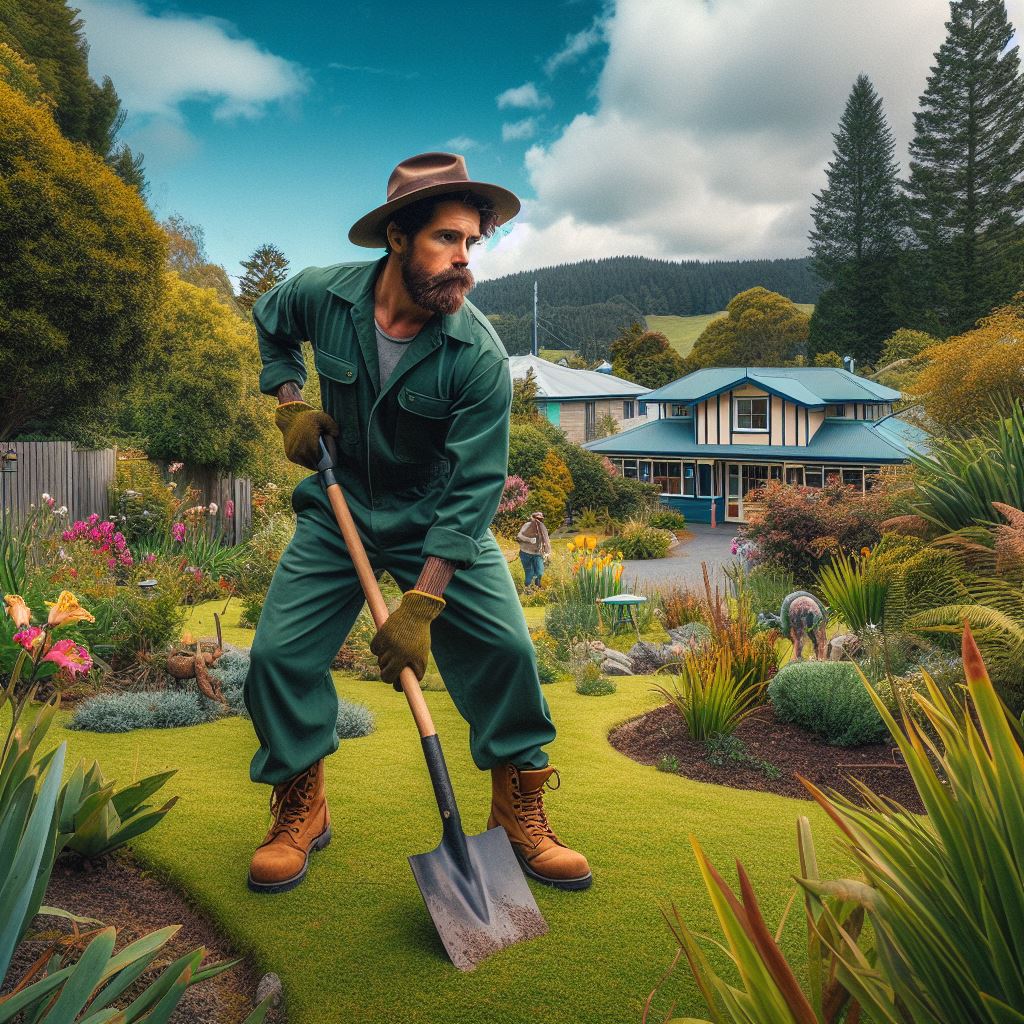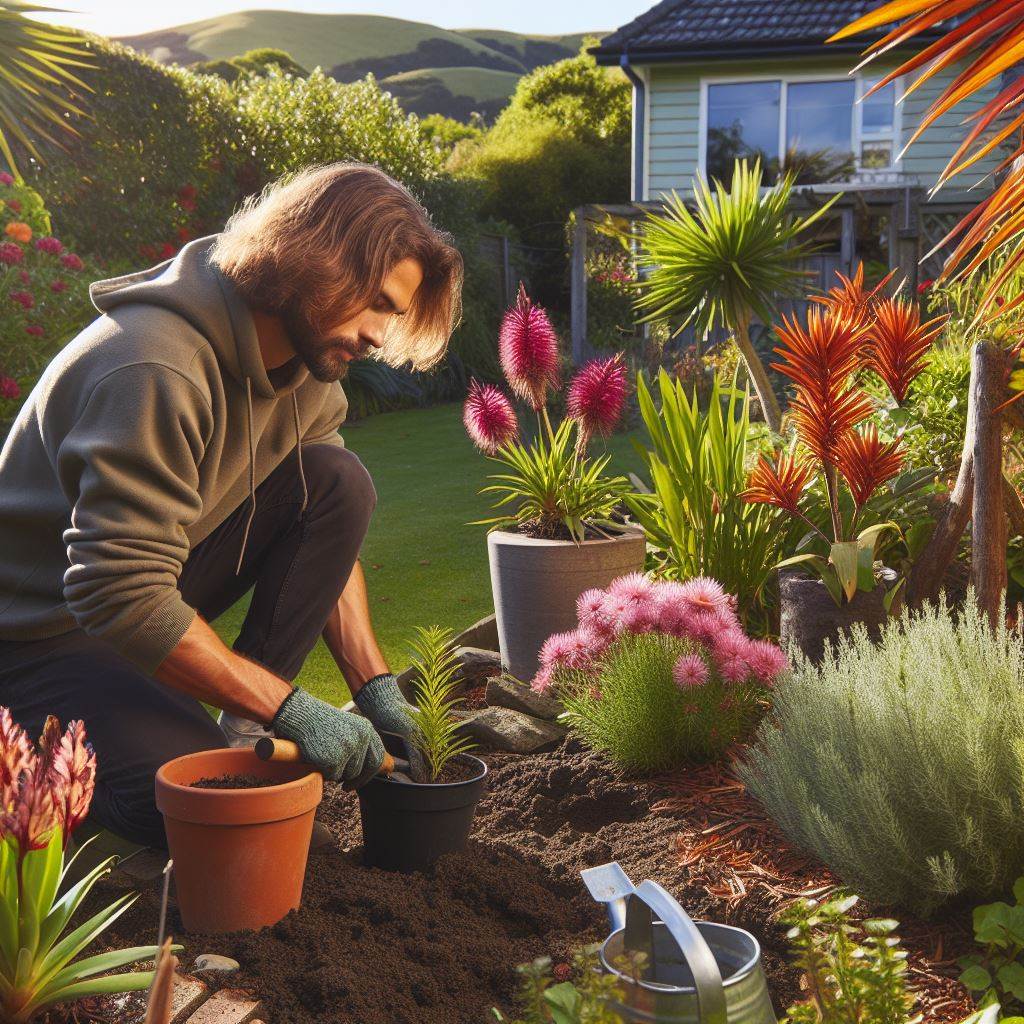Introduction
Budget landscaping refers to the process of improving outdoor spaces with limited financial resources.
Landscaping plays a crucial role in enhancing the visual appeal of outdoor areas such as gardens, yards, or balconies.
It allows individuals to create a pleasant and inviting environment for themselves and their families.
Whether it is a small space or a large one, budget landscaping offers countless opportunities to transform it into a beautiful and functional area.
By utilizing cost-effective materials and strategic planning, it is possible to achieve stunning results without breaking the bank.
Moreover, budget landscaping enables individuals to express their creativity and personalize their outdoor spaces according to their preferences and needs.
It allows them to experiment with various elements such as plants, flowers, pathways, lighting, and seating areas to create a unique and inviting atmosphere.
Additionally, budget landscaping provides numerous benefits beyond aesthetics.
It can increase property value, create privacy, improve air quality, and contribute to better mental and physical health.
With careful consideration and attention to detail, budget landscaping allows individuals to maximize the potential of their outdoor spaces and enjoy the benefits of a beautiful and functional environment.
Choosing the Right Plants
Choosing the right plants for your budget landscaping project in NZ is crucial for its success.
The plants you select can significantly impact the overall look and maintenance requirements of your outdoor space.
Here, we will discuss the significance of selecting native or low-maintenance plants, provide a list of budget-friendly plants suitable for landscaping in NZ.
Mention the importance of considering the location and climate when choosing plants.
Significance of Selecting Native or Low-Maintenance Plants
When it comes to budget landscaping, native or low-maintenance plants offer several advantages.
First and foremost, native plants are well-suited to the local climate and require less water, fertilizer, and maintenance compared to exotic species.
They are adapted to the NZ environment, making them more resilient to pests, diseases, and extreme weather conditions.
By choosing low-maintenance plants, you can save on water bills and reduce the amount of time and effort spent on garden upkeep.
These plants often have strong root systems, helping prevent soil erosion and improving the overall health of your garden.
Moreover, they attract local wildlife, such as birds and beneficial insects, which contribute to a thriving ecosystem.
List of Budget-Friendly Plants Suitable for Landscaping in NZ
When working within a budget, it’s essential to choose plants that deliver visual appeal without breaking the bank. Here’s a list of budget-friendly plants suitable for landscaping in NZ:
- Flax (Phormium tenax): Known for its vibrant foliage and hardiness.
- Koromiko (Hebe stricta): Produces beautiful purple or white flowers and thrives in coastal areas.
- Harakeke (New Zealand Flax): Offers various colors and textures, perfect for attracting native birds.
- Kaka Beak (Clianthus puniceus): Displays stunning red and pink flowers, attracting birds and bees.
- Pohutukawa (Metrosideros excelsa): Known as the New Zealand Christmas tree, it provides beautiful crimson flowers.
- Chatham Island Forget-Me-Not (Myosotidium hortensia): Features unique blue flowers and is easy to care for.
Importance of Considering Location and Climate
When selecting plants for your budget landscaping project in NZ, it’s crucial to consider your specific location and climate.
Different regions in NZ have distinct microclimates, which impact the suitability of various plant species. Factors to consider include average rainfall, temperature ranges, wind exposure, and soil type.
By choosing plants adapted to your local climate, you increase their chances of survival and reduce the need for extensive care and maintenance.
Consider visiting your local nursery or seeking professional advice to ensure you select plants that will thrive in your specific location.
Therefore, selecting the right plants is essential when planning a budget landscaping project in NZ.
Native or low-maintenance plants offer numerous benefits, such as reduced water usage and lower maintenance requirements.
By choosing budget-friendly plants suitable for NZ’s climate and taking into account your specific location, you can create a beautiful and sustainable outdoor space without exceeding your budget.
Creative Use of Mulch
The use of mulch in landscaping offers numerous benefits. It not only enhances the appearance of the garden but also helps in retaining soil moisture.
Benefits of using mulch in landscaping
- Mulch acts as a natural insulator, keeping the soil warm in winters and cool in summers.
- It helps in suppressing weed growth, reducing the need for herbicides.
- Mulch prevents soil erosion by protecting the top layer from heavy rainfall or strong winds.
- It regulates soil temperature and moisture, reducing the need for frequent watering.
Inexpensive options for mulch
- Wood chips: This is a popular choice as it adds a natural look to the garden and is readily available.
- Straw: Straw mulch is cost-effective and effective in protecting the soil from extreme temperatures.
- Grass clippings: Recycling grass clippings as mulch not only saves money but also adds nutrients to the soil.
- Leaves: Shredded leaves can be easily collected in autumn and used as mulch to promote soil health.
Proper application of mulch
- Prepare the area by removing any existing weeds or debris before applying mulch.
- Apply a layer of mulch that is approximately 2-4 inches thick, making sure it is evenly spread.
- Avoid piling up mulch near plant stems or tree trunks, as it may cause rot or fungal diseases.
- For flower beds, spread mulch around plants in a donut shape, keeping it away from direct contact with the stems.
- Use a rake or hand to gently push aside the mulch layer when planting new plants or seeds.
- Regularly monitor the mulch layer and replenish as needed, especially during rainy seasons or high winds.
Using mulch creatively can also add visual interest to your garden
- Choose colored mulches, like black or red, to create a striking contrast with your plants.
- Layer different types of mulch to create texture and depth in your landscaping design.
- Create mulch paths or walkways to define different areas of your garden and provide easy access.
- Consider using recycled materials like shredded newspapers or cardboard as an eco-friendly mulch option.
- Experiment with mulch placement around garden features or statues to create focal points.
Basically, mulch is an affordable and versatile landscaping tool. Its numerous benefits and creative use options make it a must-have for budget-conscious gardeners in New Zealand.
DIY Decorative Features
Creating beautiful decorative features for your landscaped garden doesn’t have to break the bank.
With a little creativity and some DIY skills, you can add charm and personality to your outdoor space without spending a fortune.
Here are some cost-effective ideas for easy-to-make features that will enhance the overall look of your garden:
Recycled Tire Planters
One of the most popular and environmentally friendly DIY projects for your garden is turning old tires into planters.
Not only is this a great way to recycle, but it also adds a unique and rustic touch to your landscape design.
To create your recycled tire planters, here’s what you’ll need:
- An old tire
- A knife or scissors
- A drill or nail
- Paint (optional)
- Step 1: Start by cleaning the tire thoroughly to remove any dirt or debris.
- Step 2: Use a knife or scissors to cut out the inner part of the tire, leaving a rim of about 4-6 inches.
- Step 3: If you want to add some color, paint the outer part of the tire with weather-resistant paint in your desired shade.
- Step 4: To allow for proper drainage, use a drill or nail to create small holes in the bottom of the tire.
- Step 5: Fill the tire with potting soil and plant your favorite flowers or herbs.
- Step 6: Place your new recycled tire planter in your garden or on your patio, and enjoy the unique and budget-friendly addition to your landscape.
Painted Rocks
Another fun and inexpensive way to add a personal touch to your garden is by painting rocks. This simple DIY project allows you to get creative and add pops of color to your outdoor space.
Here’s how to create your own painted rocks:
Personalized Career Consulting
Unlock your potential with expert career advice tailored to your goals. Get personalized guidance and actionable steps toward your dream career in New Zealand.
Get Started- Smooth rocks in various sizes
- Acrylic or outdoor paint
- Paintbrushes
- Sealant (optional)
- Step 1: Start by collecting smooth rocks of different shapes and sizes from your garden or a nearby river.
- Step 2: Clean the rocks and let them dry completely before painting.
- Step 3: Use acrylic or outdoor paint to create your desired designs on the rocks.
- Step 4: Let the paint dry, and if desired, apply a layer of sealant to protect your designs from the elements.
- Step 5: Arrange your painted rocks strategically in your garden, by the edge of a pathway, or next to a plant bed.
Painted rocks can also be used as markers for different plants or simply as decorative elements scattered throughout your garden. The possibilities are endless!
By incorporating DIY decorative features like recycled tire planters and painted rocks into your landscape design, you can achieve a unique and budget-friendly outdoor space.
These easy-to-make projects not only add visual interest but also allow you to express your creativity. So why not give them a try and transform your garden into a personalized oasis?
Read: The Impact of Technology on NZ Electricians
Simple Water Features
When it comes to budget landscaping ideas in NZ, incorporating water features can be an affordable and beautiful option.
Here, we will discuss the affordability of water features, suggest options like small fountains or DIY birdbaths, and provide tips for their proper installation and maintenance.
Affordability of Water Features
Water features are an excellent way to add visual interest and a soothing ambiance to your outdoor space without breaking the bank.
Unlike elaborate ponds or large-scale waterfalls, simple water features can be quite affordable.
Suggested Options
- Small Fountains: A small fountain can be an elegant addition to any backyard.
They are available in various styles and sizes, allowing you to choose one that fits your budget and complements your existing landscaping. - DIY Birdbaths: Creating your own birdbath can be a cost-effective and rewarding project.
You can use items such as terracotta pots, old sinks, or even repurposed kitchenware to make a unique birdbath that birds will love.
Installation and Maintenance Tips
- Location: Choose a suitable location for your water feature, ensuring it has access to a power source if required. Consider the proximity to plants, as falling leaves may clog the fountain or birdbath.
- Proper Leveling: Ensure that the ground where you plan to install the water feature is level. This will prevent any leaks and ensure proper water circulation.
- Water Source: Depending on the type of water feature you choose, you may need to connect it to a water supply. Plan the plumbing carefully, taking into account the location of existing water pipes.
- Adding Fish or Plants: If you plan on adding fish or aquatic plants, ensure you create a suitable environment for them. Research the specific requirements of the fish and plants you intend to include.
- Cleaning and Maintenance: Regularly clean the water feature to prevent the buildup of algae.
Remove any debris, such as fallen leaves or twigs, to maintain its aesthetic appeal. Additionally, check the pump or fountain head for any clogs or damages.
In fact, Incorporating water features into your budget landscaping in NZ is an affordable and rewarding endeavor.
Simple options like small fountains or DIY birdbaths can bring serenity and beauty to your outdoor space.
Just remember to choose a suitable location, properly install and maintain the water feature, and enjoy the soothing sounds of flowing water in your garden.
Read: Apprenticeships in Electrical Work: NZ Focus

Maximizing Space through Vertical Gardening
Vertical gardening is a gardening technique that involves growing plants vertically, utilizing the walls, fences, or any available vertical space to maximize limited space.
This innovative gardening method has gained popularity in New Zealand due to its numerous advantages for small spaces.
Some advantages of vertical gardening in small spaces
- Optimal Space Utilization: Vertical gardens allow you to make the most out of limited space by utilizing vertical surfaces.
- Enhanced Aesthetics: Vertical gardens add a unique and visually appealing element to your outdoor space.
- Improved Air Quality: Plants in vertical gardens help improve air quality by absorbing pollutants and releasing oxygen.
- Easier Maintenance: Vertical gardens are usually more accessible, making watering, pruning, and harvesting easier tasks.
- Reduced Weed Growth: Vertical gardening reduces the chances of weed growth and minimizes the maintenance required.
Here are some ideas for vertical garden structures
If you’re interested in implementing vertical gardening in your small space,
- Pallet Planters: Reusing pallets as planters is an inexpensive and eco-friendly way to create a vertical garden.
- Wall-Mounted Containers: Install wall-mounted containers or hanging baskets on your walls or fences for easy vertical gardening.
- Trellises and Arbors: Use trellises or arbors to support climbing plants and create a vertical green wall.
- Vertical Hydroponics: Set up a hydroponic system that allows you to grow plants vertically without soil.
- Outdoor Shelves: Install shelves or tiered garden racks to display potted plants vertically.
Here are some suitable plant suggestions
When choosing plants for your vertical garden in NZ, it is essential to select varieties that thrive in the local climate and conditions.
- Herbs: Mint, thyme, rosemary, and basil are excellent choices for vertical gardens.
- Succulents: Drought-tolerant succulents like sedums, echeverias, and hens and chicks are low-maintenance options.
- Flowers: Petunias, begonias, and impatiens add vibrant colors to your vertical garden.
- Leafy Greens: Lettuces, spinach, and kale can be grown vertically and provide a fresh supply of greens.
- Strawberries: Vertical gardening is perfect for growing strawberries, as they can be easily hung or stacked.
To ensure the success of your vertical garden, consider the following tips
- Provide Adequate Watering: Proper irrigation is essential for vertical gardens, as water can easily drain or evaporate.
- Position the Garden Strategically: Ensure your vertical garden gets sufficient sunlight and access to water sources.
- Regular Maintenance: Regularly check and maintain your vertical garden by pruning, fertilizing, and removing any diseased or dead plants.
- Consider Plant Placement: Group plants with similar water and sunlight needs together for easier maintenance.
- Monitor Plant Growth: Keep an eye on your plants’ growth and adjust the supporting structures as required.
Vertical gardening is an excellent option for maximizing space and creating a stunning green oasis in your small outdoor area.
With the right structures, suitable plants, and proper maintenance, you can enjoy the benefits of a thriving vertical garden in New Zealand.
Read: Women in Electrical Trades: NZ’s Growing Trend
Utilizing Natural Elements in Budget Landscaping Ideas in NZ
When it comes to budget landscaping ideas in NZ, incorporating natural elements can be both beautiful and cost-effective.
Rocks and driftwood, for example, can add a unique touch to your landscape while keeping expenses low. Here are some tips for selecting and arranging these elements to create a balanced and harmonious design.
Selecting Natural Elements
- Look for rocks or driftwood that have interesting shapes, textures, and colors.
- Consider the size and scale of your landscape when choosing these elements.
- Opt for locally sourced materials to save on transportation costs.
Arranging Natural Elements
- Create focal points by strategically placing rocks or driftwood in key areas of your landscape.
- Use different sizes and shapes to add variety and visual interest.
- Arrange them in groupings or clusters to create a natural and organic look.
Maintaining a Balanced Design
- Pay attention to the overall composition of your landscape.
- Ensure that the natural elements you incorporate complement the existing plants and features.
- Avoid overcrowding the space with too many rocks or driftwood pieces.
Adding Functionality
- Rocks can be used to create pathways, borders, or even seating areas.
- Driftwood can be repurposed as garden fences, trellises, or decorative elements.
- Consider the practical uses of these natural materials to maximize their value.
Enhancing the Aesthetic Appeal
- Use plants to soften the look of rocks and driftwood, blending them seamlessly into the landscape.
- Incorporate native plants that thrive in your region for a more sustainable and low-maintenance design.
- Experiment with different colors and textures to create visual contrast and depth.
DIY Opportunities
- Collect rocks or driftwood from nearby beaches, rivers, or forests to save money.
- Get creative and try your hand at crafting unique pieces, such as rock sculptures or driftwood art.
- Involve the whole family in collecting and arranging these natural elements for a fun and collaborative project.
Maintenance and Care
- Regularly inspect and clean the natural elements to prevent the buildup of dirt and debris.
- Be mindful of any potential hazards, such as loose rocks or sharp edges, and address them promptly.
- Prune and maintain surrounding plants to ensure they don’t overshadow or obstruct the natural elements.
Long-Term Durability
- Choose rocks and driftwood that are durable and weather-resistant to withstand New Zealand’s climate.
- Consider treating the materials with protective coatings or sealants for added longevity.
- Monitor the condition of the natural elements over time and make necessary replacements or repairs.
By utilizing natural elements in your budget landscaping, you can create a visually stunning and cost-effective outdoor space.
Selecting and arranging rocks or driftwood with care, while maintaining a balanced design, can transform your landscape into a harmonious haven.
So, embrace the beauty of nature and let it enhance your NZ landscape without breaking the bank.
Transform Your Career with a Professional CV and Cover Letter
Stand out to employers with an ATS-optimized resume and tailored cover letter designed to match your dream role. Let us craft your job application materials for success!
Get StartedRead: Electrical Code Updates 2024: What NZ Needs to Know
Conclusion
In closing, we have explored several key budget landscaping ideas for New Zealand homeowners.
These include repurposing materials, opting for low-maintenance plants, and utilizing natural elements.
By incorporating these ideas, readers can create beautiful outdoor spaces on a budget.
It is important to remember that landscaping is an art, and creativity should be encouraged.
Don’t be afraid to experiment with different ideas and styles, as this can result in a unique and personalized space.
Lastly, budget-friendly landscaping has the power to transform your property.
With some careful planning and resourcefulness, you can achieve a stunning outdoor oasis without breaking the bank. So, go ahead and give it a try – you’ll be amazed at the results!




